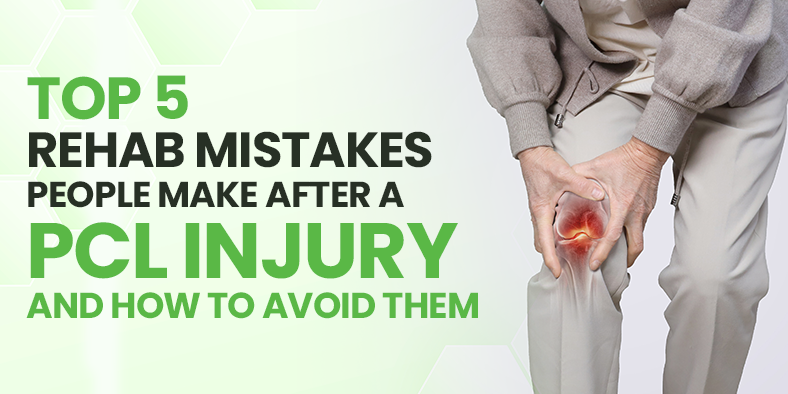Recovering from a Posterior Cruciate Ligament (PCL) injury takes more than just time—it requires a well-structured, patient-centered rehabilitation plan. While most people understand the importance of physiotherapy after such injuries, many unknowingly fall into common pitfalls that delay or even derail recovery. Whether you’re an athlete, a fitness enthusiast, or someone who injured your knee in an accident, avoiding these mistakes is essential for a successful outcome.
In this article, we’ll explore the top 5 PCL rehab mistakes, why they happen, and how you can sidestep them to ensure a full, safe return to your regular activities.
Introduction to PCL Injuries and Rehabilitation
The PCL is one of the key ligaments in the knee that helps stabilize the joint by preventing the tibia (shin bone) from moving too far backward. Unlike the ACL (anterior cruciate ligament), PCL injuries are less common but can still cause serious dysfunction, particularly in athletes and active individuals.
Rehabilitation following a PCL injury is crucial. The recovery process typically involves a combination of rest, physical therapy, gradual strengthening, and functional training. However, common rehab mistakes after PCL tear can prevent proper healing and lead to long-term knee issues.
1. Skipping the Initial Rest and Recovery Phase
- Mistake:
Many people feel tempted to “walk it off” or return to mild activity too quickly, especially if the pain subsides after a few days. They may skip or shorten the initial rest phase, assuming it’s only needed for severe injuries. - Why It’s a Problem:
The early phase after a PCL tear is critical for reducing inflammation, minimizing swelling, and allowing the ligament to begin healing. Pushing through pain or skipping rest can worsen the damage and prolong recovery. - How to Avoid It:
Take your doctor’s or physiotherapist’s advice seriously. The first 1–2 weeks should focus on rest, elevation, compression, and ice therapy, followed by controlled passive movements as recommended. Avoid bearing full weight on the injured leg unless specifically advised.
2. Returning to Sports or Activities Too Soon
- Mistake:
One of the most dangerous rehab mistakes after a PCL injury is trying to resume sports, running, or intense gym workouts before the knee is fully healed. This often happens due to impatience or external pressure to perform. - Why It’s a Problem:
The knee may feel better before it’s actually strong or stable enough to handle dynamic movements. Premature return to activity can re-injure the ligament or even cause compensatory injuries in other joints due to instability. - How to Avoid It:
Understand that healing is not just about how your knee feels—it’s about regaining full strength, range of motion, and neuromuscular control. Always follow your rehab provider’s clearance protocols for returning to sports after PCL injury, which may include clinical assessments, movement screenings, and strength benchmarks.
3. Neglecting Strength and Stability Training
- Mistake:
Some individuals do basic mobility exercises and then stop therapy once the pain subsides, ignoring the critical phase of strength and proprioception training. - Why It’s a Problem:
Without rebuilding muscle strength—especially in the quadriceps, hamstrings, glutes, and calf muscles—the knee joint remains unstable and more prone to future injuries. Poor joint control also increases the risk of falls or strains during daily activities. - How to Avoid It:
Stick with your rehab plan even after symptoms improve. Focus on progressive resistance training, single-leg stability drills, balance work, and functional movement patterns. Engage in activities that strengthen the entire kinetic chain, not just the knee.
4. Not Following a Personalized Rehab Plan
- Mistake:
Many people use generic rehab programs found online or follow exercises given to friends with similar injuries. Others may attend therapy inconsistently or change therapists mid-way through treatment without proper handover. - Why It’s a Problem:
Every PCL injury is different—some are isolated, while others occur with meniscus tears or other ligament damage. A generic or inconsistent approach can overlook individual biomechanical needs or healing timelines. - How to Avoid It:
Work with a licensed physiotherapist or orthopedic rehab specialist who customizes your plan based on:
- The grade of your PCL injury
- Any accompanying damage
- Your sport or activity level
- Your age, weight, and muscle balance
A personalized approach ensures optimal progression through different rehab phases.
5. Ignoring Pain or Swelling During Rehab
- Mistake:
Pain and swelling are often seen as “normal” during exercise, especially by athletes. Some ignore these warning signs, assuming that pushing through will build toughness or speed up results. - Why It’s a Problem:
Persistent or increasing pain, especially during weight-bearing or specific movements, indicates irritation or re-injury. Swelling reflects internal inflammation and should never be dismissed. - How to Avoid It:
Monitor your symptoms closely and report them to your therapist. Use pain and swelling as feedback, not obstacles. If your knee becomes sore or swollen after a session, it may be a sign that you progressed too quickly or need to modify your exercises.
Also read: Posterior Cruciate Ligament Injuries Treatment in Chandigarh
How to Avoid These Mistakes and Ensure a Full Recovery
Recovering from a PCL injury doesn’t have to be a frustrating or drawn-out process. The key is to stay informed, committed, and guided by professionals. Here are some practical steps to support your recovery:
1. Stick to a Structured Timeline
Rehabilitation takes place in phases:
- Acute Phase (0–2 weeks): Focus on reducing inflammation.
- Sub-Acute Phase (2–6 weeks): Gentle mobility and isometric strengthening.
- Intermediate Phase (6–12 weeks): Functional exercises, strength training.
- Advanced Phase (3–6 months): Return-to-play protocols, agility, and balance.
Rushing through any phase can lead to setbacks.
2. Prioritize Communication
Stay in close contact with your physiotherapist or doctor. Share your concerns, ask questions, and don’t hesitate to revisit earlier exercises if needed.
3. Set Realistic Milestones
Rather than aiming for quick results, set gradual milestones:
- Restoring full range of motion
- Standing without support
- Pain-free climbing of stairs
- Jogging without limping
- Returning to competitive sport
Track these with the help of your rehab provider.
4. Invest in Professional Guidance
Online videos and generic apps can’t replace professional insight. At least in the early stages, prioritize in-person assessments to ensure you’re moving correctly and strengthening safely.
5. Listen to Your Body
Your body will tell you when something isn’t right. Learn to distinguish between muscle soreness (normal) and joint pain (concerning). Don’t ignore new symptoms like locking, instability, or swelling—these could signal complications.
Conclusion
A PCL injury can be a tough road, but it doesn’t have to define your athletic or physical journey. By understanding and avoiding the top 5 PCL rehab mistakes, you empower yourself to recover fully, regain strength, and return to the activities you love with confidence.
Whether you’re a competitive athlete or someone just hoping to walk pain-free again, the quality of your rehabilitation matters. Avoid rushing, skipping steps, or going it alone. Instead, partner with professionals, follow a personalized plan, and give your knee the time it needs.
If you’re in recovery from a PCL injury or preparing for rehab, remember: the smartest thing you can do is do it right the first time.
Need help with your PCL rehab journey?
Our experienced physiotherapists and sports rehab experts are here to guide you through a personalized plan, minimize your risk of re-injury, and get you back on your feet, stronger than before.


